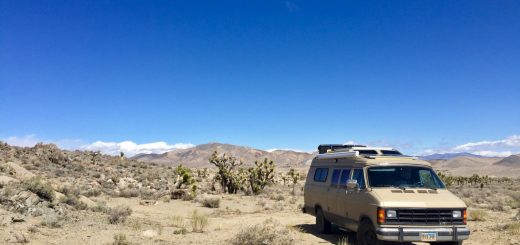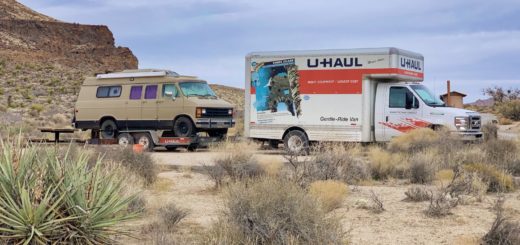Increasing the MPG in the Big Blue Van
Driving or towing a larger vehicle, such as a van or RV, can really break the bank quickly. Fuel cost is one of the largest costs for any full-time traveler. We can all dream of getting 20+ MPG, but the realities of this lifestyle is very different. Most gasoline-engine RVs, vans, or truck & trailer combinations are going to give you single-digit or below teen MPG numbers.
There are a few considerations you can take before making any vehicle purchase if you have not already gotten that far;
- Electronic Fuel Injection (EFI) self tunes the air/fuel mixture as you drive. The on board computer will reduce the amount of fuel when the outside air temperatures increase, or when your elevation increases. This makes it not only more efficient on fuel (by 10-20%) over carbureted engines, you also do not have to fiddle with the engine to go up into the mountains. Most late 80’s to modern day engines are EFI.
- Engine size plays a huge roll. If you are not planning on towing a trailer vehicle behind you, you may want to look at van or RVs with smaller engines. The bigger V8 engines (greater than 400 cubic inches or 6+ liters) are great for towing but will get only single-digit fuel mileage even when going downhill… with a tail wind. The mid-sized V8 engines (340-360ci) are neither extremely powerful or fuel efficient. You can realistically plan on 10-13 highway MPG with any of these with EFI and proper driving. You can do some light towing with the mid-range motors at some loss to your mileage. Lastly, the small-block V8 engines (300-320 ci) can provide up to 18 highway MPG but you should seriously limit any towing you plan to do.
And then there are the things you can do no matter the vehicle you drive;
- A well maintained vehicle will get better MPG. New plugs, wires, filters, and fluids will save you money at the pump
- Keep your speeds at or below 60 miler per hour. I only drove 55-60 MPH on the Interstates (sorry truckers), every where else I topped out at 45, no matter what the speed limits were.
- Tire pressures! I actually run mine at the max psi marked on the tires, and then be sure to check them regularly. Depending on where you fill your tires, your PSI may change as you gain or drop elevation. Each tire is different, but I have found about 0.5 PSI difference for every 1000 ft in elevation. 32 psi in Colorado will drop to 29 PSI by the time you get to California. The bigger the tire, the larger the drop/increase.
- Accelerate normally (not slowly) and get into the final gear faster, then lift off to coast. Your engine will get optimal MPG only in top gear.
- Coast to stop lights in gear (do not use neutral). Your engine uses practically no fuel coasting while in gear (its true!), but it actually does use fuel to keep the motor running while in neutral
- Do not accelerate up hills. Coast up them, and accelerate down them, but do be aware of that line of vehicles behind you.
- Use cruise control when on flat ground (I turn it off on hills to avoid it from accelerating up hills)
- Fuel up when it is coldest (early AM) as the fuel is more dense in colder temperatures
- Drive when it is warmest (afternoon) as air is less dense when it is hotter which is a double positive;
- Less dense air is easier to push through (less drag)
- Warm air has less oxygen. Less oxygen to your engine and your EFI compensates by delivering less fuel
- High altitude driving consumes less fuel (same reason as above)
- Obviously, turn off the A/C if you can
- And to take it further, turn off all accessories. You radio, lights, sat-nav, etc all take power which must be recharged by the alternator which gets it’s power from the engine via belts. The less power you use inside, the less power being taken from your motor to recharge that energy you use inside.
- Roll up your windows. A single open window can reduce your MPG by 5%. Four open widows = same as having your A/C on.




